 |
Roberts R303 U.K. - 1967 |
 |
 Description
Description |
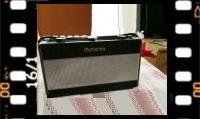 |
Descrizione Schema elettrico |
|||
|
|
|||||
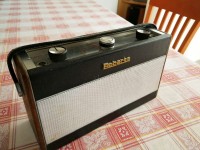 |
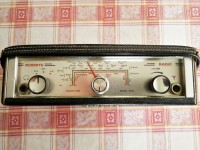 |
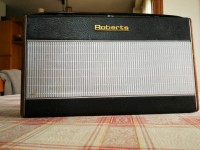 |
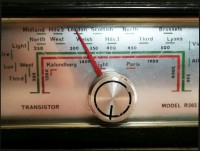 |
||
|
Rispetto al precedente modello R300, con la R303 la Roberts compì un'evoluzione stilistica e tecnica. La tipica forma a cofanetto, adottata sin dal 1954 con il modello portatile a valvole R55, fu abbandonata in favore di una sagoma più squadrata, un po' più larga e più stretta. La radio era portatile ed era munita di cinghia per il trasporto ma manteneva dimensioni piuttosto ragguardevoli in netta contro tendenza con i transistor tascabili super miniaturizzati prodotti in Giappone negli anni '60. Le dimensioni della R303 però, in unione al mobiletto di legno, all'altoparlante Rola ellittico da 17.8 x 13,58 cm e al ben dimensionato amplificatore audio, fornivano ottime prestazioni acustiche che permettevano di ascoltare musica e voce in modo gradevole. L'apparecchio era una supereterodina che riceveva le Onde Medie (da 525 a 1630 kHz) ele Onde Lunghe (da 150 a 265 kHz). Il circuito elettrico impiegava otto transistor al germanio: AF115 AF117 AF117 BC149 AC127 AC127 AC128 AC128 e un diodo al silicio BA114. I tre transistor AF11x dello stadio a Radio Frequenza e Frequenza Intermedia erano situati all'interno del modulo LP1159 prodotto dalla Mullard. L'antenna per OM e OL era avvolta su nucleo di ferrite ma sulla scala parlante della radio c'era una presa a cui poteva essere collegata un'antenna esterna, utilizzabile per esempio quando ci si trovava in auto. La frequenza intermedia risuonava a 470 kHz, mentre lo stadio audio con il circuito di potenza a simmetria complementare (AC127-AC128) forniva 1,2 Watt all'altoparlante ellittico Rola da 10 Ohm. Come nei ricevitori a transistor Roberts precedenti anche la R303 era dotata del disco di plastica girevole alla base, che permetteva la rotazione dell'apparecchio per captare meglio il segnale. Nel pannello superiore della radio c'era la scala parlante e tre manopole: quella centrale era il controllo della sintonia mentre a sinistra si trovava la presa per l'auricolare e il commutatore di gamma e interruttore di accensione (OM - OFF - OL). A destra c'era il controllo del volume e la presa per l'antenna esterna. L'alimentazione della R303 era fornita da una grossa batteria da 9 V tipo PP9 o equivalente posta nella parte inferiore del mobile che permetteva una discreta autonomia. Le dimensioni della radio erano: 26 x 15 x 8 cm, e il peso era di 1.4 kg senza le batterie. L'esemplare che sono riuscito a rintracciare aveva il numero di serie 7594 e per rimetterlo in funzione ho dovuto smontare, sistemare e rimontare il commutatore rotativo del cambio gamma che presentava problemi meccanici. Poi ho sostituito i condensatori elettrolitici C5 e C14 che erano in perdita e ho pulito con l'apposito spray pulisci contatti il potenziometro del volume e il commutatore di gamma-interruttore di accensione. IK3HIA © 2020. |
|||||
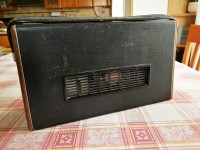 |
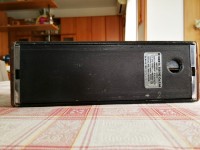 |
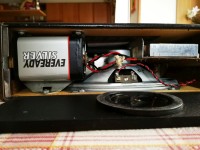 |
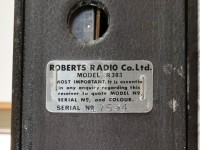 |
||
 Roberts R303 - Roberts Radio Co. Ltd.,
East Molesey, Surrey, U.K. - 1967
Roberts R303 - Roberts Radio Co. Ltd.,
East Molesey, Surrey, U.K. - 1967With the R303, compared to the previous R300 model, Roberts made a stylistic and technical evolution. The typical box shape, adopted since 1954 with the portable valve model R55, was abandoned in favor of a more squared shape, a little wider and narrower. The radio was portable and equipped with a strap for transport but maintained rather considerable dimensions in clear contrast with the super miniaturized pocket transistors produced in Japan in the 60s. However, the dimensions, together with the wooden material with which the R303 cabinet was built, the elliptical Rola speaker of 7x5 inch and the well-sized audio amplifier, provided excellent acoustic performance that allowed listening to music and voice in a pleasant way. The device was a superheterodyne that received MW Broadcasting (from 525 to 1630 kHz) and Long Waves (from 150 to 265 kHz). The electrical circuit used eight germanium transistors: AF115 AF117 AF117 BC149 AC127 AC127 AC128 AC128 and a silicon diode BA114. The three AF11x transistors of the Radio Frequency and Intermediate Frequency stage were located inside the LP1159 module produced by Mullard. The antenna for OM and OL was wound on a ferrite core but on the dial of the radio there was a socket to which an external antenna could be connected, usable for example in a car. The intermediate frequency resonated at 470 kHz, while the audio stage with the complementary symmetry power circuit (AC127-AC128) supplied 1.2 Watts to the 10 Ohm Rola elliptical speaker. As in previous Roberts transistor receivers, the R303 was also equipped with the rotating plastic disk at the base, which allowed the rotation of the device to better capture the signal. On the top panel of the radio there was the dial and three knobs: the central one was the tuning control while on the left there was the earphone socket and the range switch and power switch (MW - OFF - LW). On the right there was the volume control and the socket for the external antenna. The power supply of the R303 was provided by a large 9 V battery type PP9 or equivalent placed in the lower part of the cabinet that allowed a reasonable autonomy. The dimensions of the radio were: 10.2 x 5.9 x 3.1 inch, and the weight was 3 lb 1.3 oz without batteries. The example I managed to track down had the serial number 7594 and to get it working again I had to disassemble, fix and reassemble the rotary switch of the range change which had mechanical problems. Then I replaced the electrolytic capacitors C5 and C14 which were leaking and I cleaned the volume potentiometer and the range switch-power switch with the appropriate contact cleaner spray. IK3HIA © 2020. |
|||||
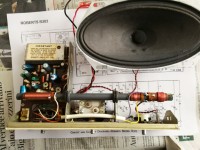 |
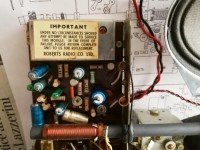 |
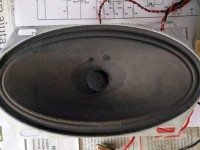 |
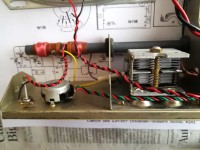 |
||
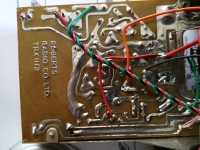 |
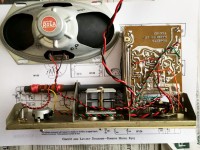 |
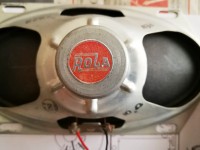 |
 |
||
 |
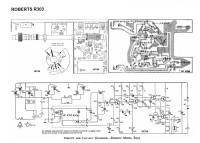 |
 |
|||
|
Back to the top of the page
|
|||||
|
|
Return to: IK3HIA home page |
|
Return to: Roberts Radio page |
|
Return to: Transistor Radio |